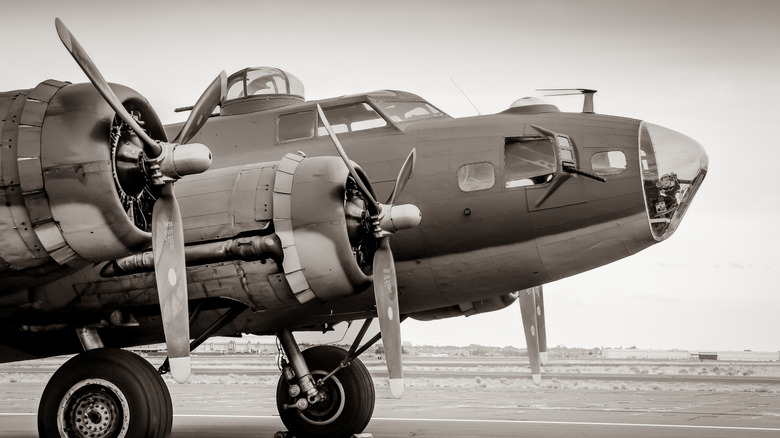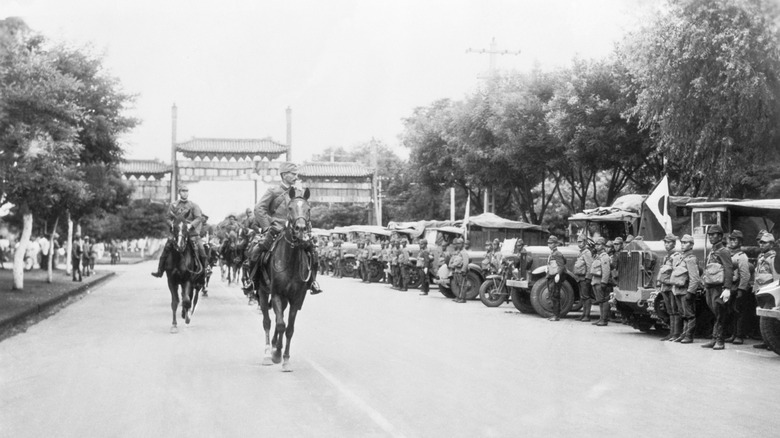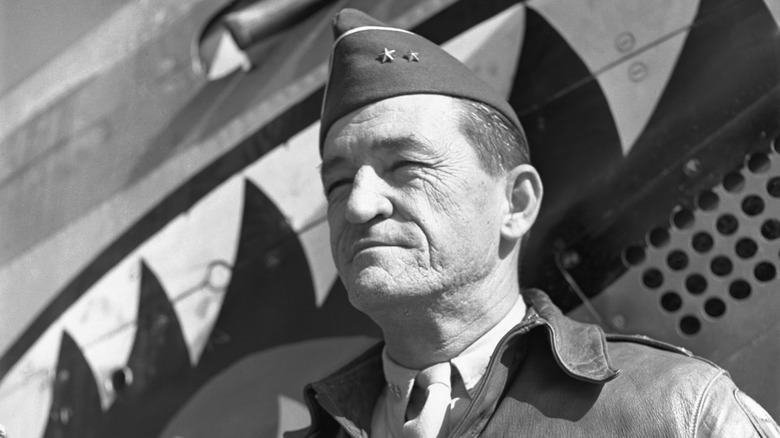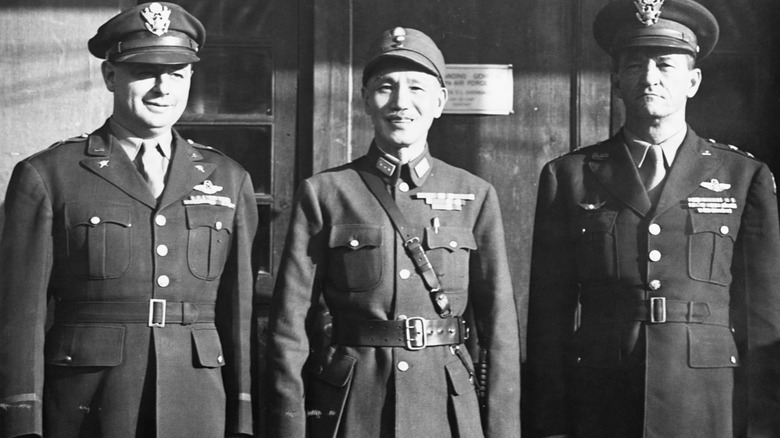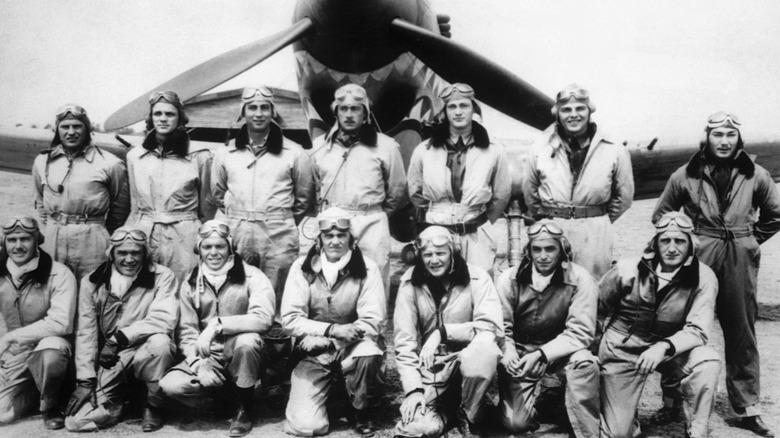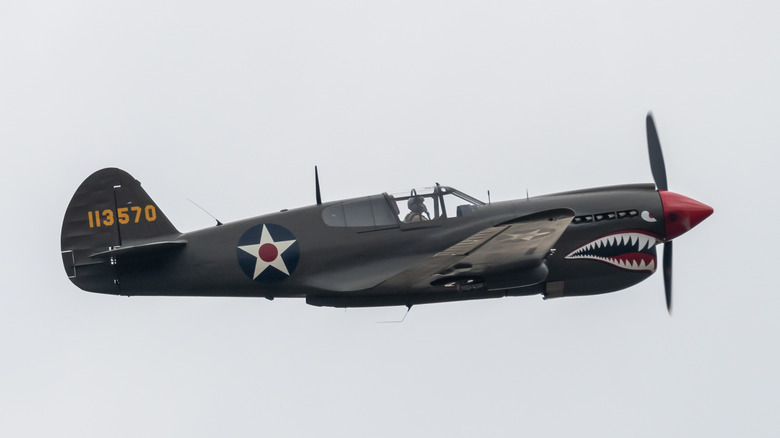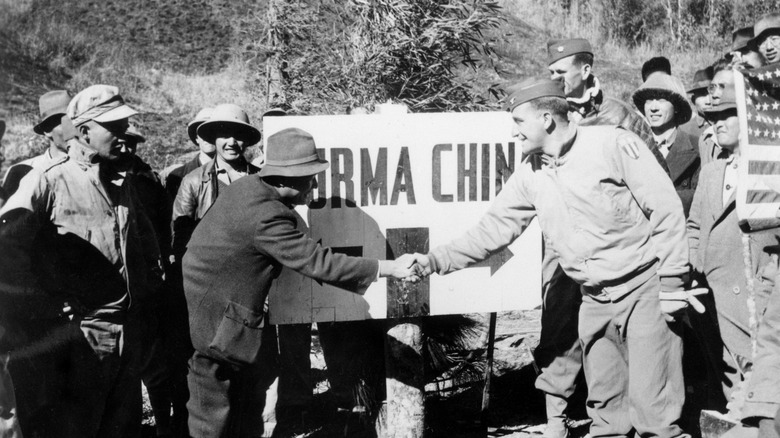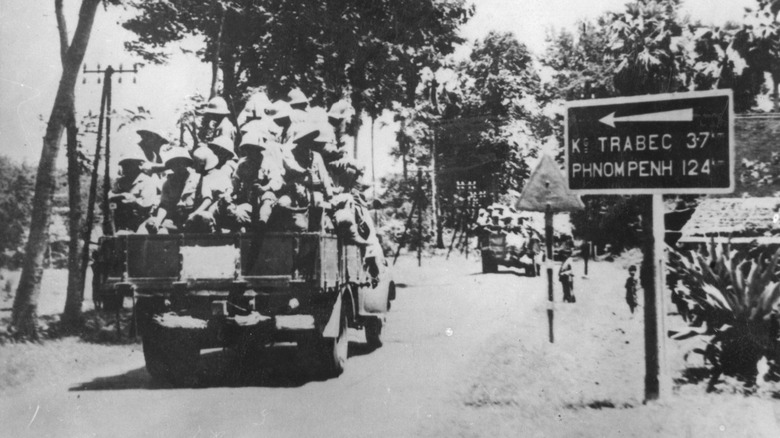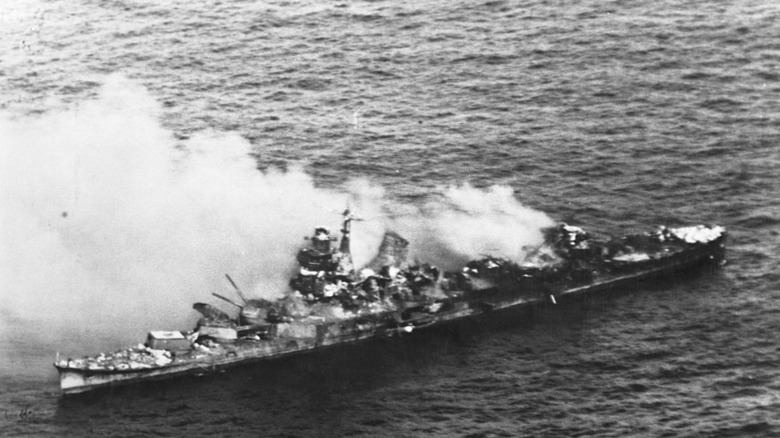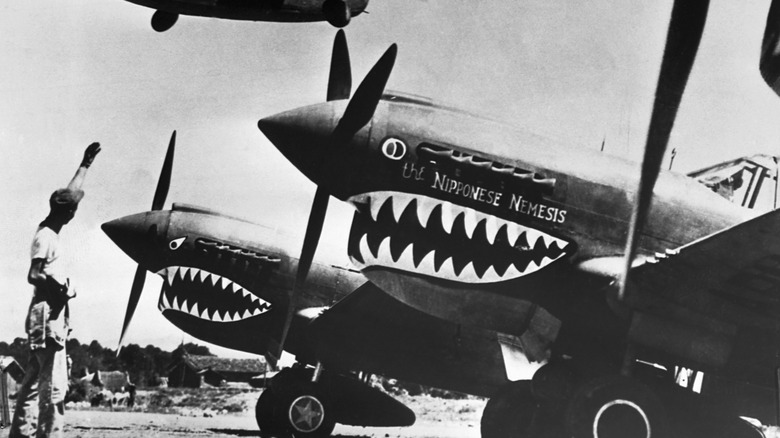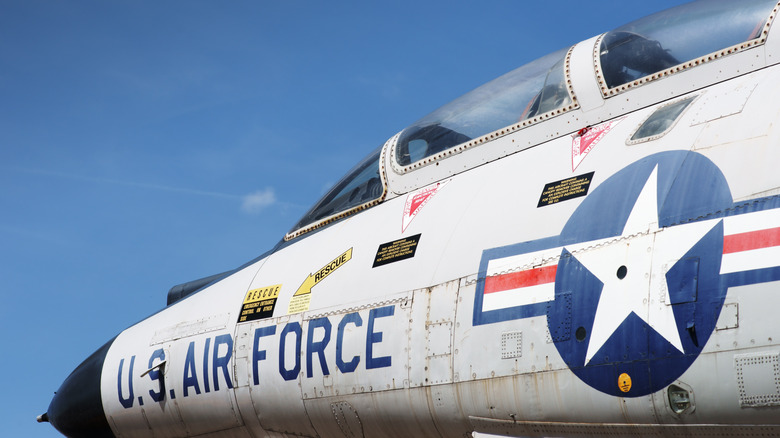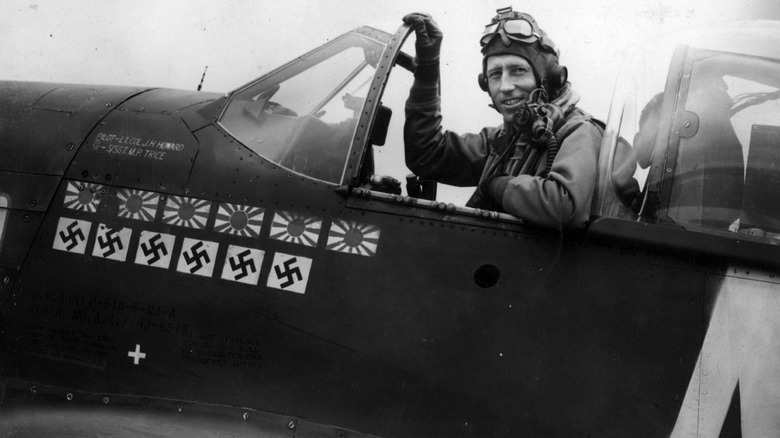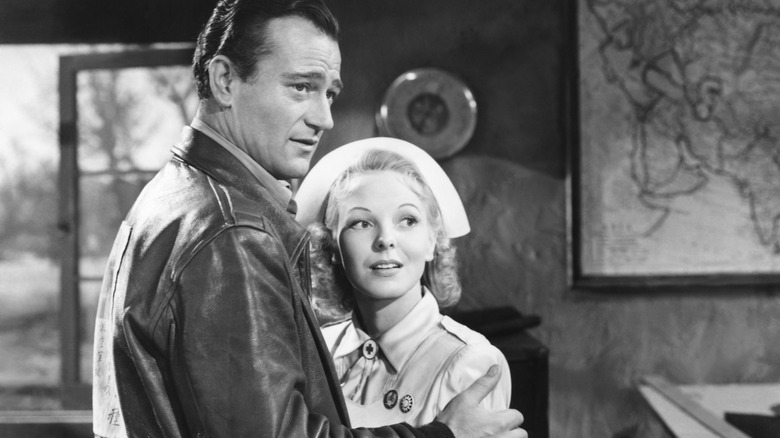The US Pilots Who Defended China From Japan
Before the United States formally entered World War II, a handful of Americans had already taken to the skies in battle against Japan. The Flying Tigers, led by World War I veteran Claire Chennault, were an all-volunteer force of American pilots who fought for the Nationalist government of China as it strove to blunt the Japanese advance. Even though they were in Chinese service, the Flying Tigers struck the first American blows against the Empire of Japan, and their efforts helped keep China on its feet to continue prosecuting the war — an important factor when the United States formally joined the war effort in late 1941.
A symbol of American grit after Japan's shocking advances in the first weeks of their war against the United States, the Flying Tigers, and their distinctive fighter planes painted to look like angry sharks, cheered up Americans and helped them brace for the long war ahead. Their legacy also stands as an example of rare but successful U.S.-Chinese cooperation in pursuit of a common goal.
By 1940, China was losing its war against Japan
In 1940, Japan had China on the ropes. By 1932, they'd gobbled up the meaty northeastern province of Manchuria, and in 1934 they had tried to establish China as a pseudo-protectorate in which no other power was allowed to operate without Japanese consent. (Chinese consent was not mentioned.) China, embroiled in a civil war between Nationalist and Communist forces, was only able to muster a semblance of unification against Japan in late 1936, but this was too little, too late. When full-scale war finally erupted between China and Japan in 1937, Japan was much better prepared, and its forces advanced rapidly over swathes of eastern China.
Beijing, Tianjin, Shanghai, and the nationalist capital Nanjing had all fallen to the Japanese by the end of 1937, with Nanjing savaged in a horrific sack that killed hundreds of thousands of civilians. In 1938, Canton and the new capital, Hankow, were both captured. Japanese forces bit off seaports, advanced along railway lines, and pelted Chinese cities with lethal air raids. When France fell to Germany in 1940, Japan snapped up its colony in Indochina and opened another front. Battered, divided, under partial occupation, and less industrialized and equipped than their persecutors, China was unable to counterattack effectively, and any path to victory was difficult to discern.
Hoping to fight back, the Chinese recruited American pilot Claire Chennault
Aware that a stronger air force would be necessary in the brewing conflict with Japan, the Chinese Nationalist government recruited a U.S. Air Force veteran shortly after his retirement in 1937. Louisianan Claire Chennault was on the verge of relocating to his farm when he was offered a role whipping the Chinese air force into shape.
By some metrics, Chennault was an unlikely choice. He had not passed pilot selection in the early days of American involvement in World War I, though he was ultimately transferred to the aviation department of the army and served in the Signal Corps. By 1937, he had lost much of his hearing from flying in loud, open cockpits and suffered from chronic bronchitis. He had also scrapped with the conventional wisdom of the U.S. military, which prioritized bombers, while Chennault believed that fighters were an important part of an effective air force.
Chennault arrived just before the Second Sino-Japanese War exploded. He inherited an ineffective force that immediately came under enormous pressure from the Japanese, but the leathery, dogged airman was willing to stay in the fight.
The Chinese Air Force was in bad shape
The Chinese forces, once unified against Japan — albeit with a promise to resume the civil war once circumstances permitted — did not have the air power necessary to defend against the viciously effective Japanese air war. Their airplanes were in poor shape, and they lacked well-trained pilots to fly the few that were functional. The previously friendly Soviet Union cut China off in 1940, preferring to flirt with the Axis powers in a dalliance that would have disastrous consequences for Central Europe and the Soviet Union itself. But if the Chinese were to survive long enough to laugh at Soviet hubris, they needed more airplanes, and they wouldn't be coming from Russia.
Via a complex system of companies made to create the illusion that the supposedly neutral U.S. was not directly helping supposedly non-allied China, the Nationalist government was able to secure the purchase of 100 fighter planes from the United States. Given the dearth of good-enough Chinese pilots (and without the luxury of time to train them), Chennault had to find people to get these planes in the air and shooting down Japanese craft, and fast.
Chennault recruited American pilots
In order to defend Chinese skies, Chennault decided that what he really needed were American pilots to supplement what forces China had. As the United States was not yet directly involved in World War II, this was not technically a project that the U.S. government formally assisted. That said, part of the project's funding came from a company set up for the purpose by, among others, a close adviser of President Roosevelt, and interested fighters were allowed to resign from the U.S. armed services in order to sign up as independent contractors in the service of the Chinese government. Roosevelt, along with many in the U.S. military and security apparatus, knew that if Chinese resistance collapsed, Japan would be in an excellent position to confront the United States without distractions, if and when it chose to.
So during the summer of 1941, 99 pilots, about 200 support staff, and 100 U.S.-made fighter planes made their way to China to begin the arduous process of rolling back Japanese domination. The pay was good, with bonuses for downed Japanese planes, the adventure was thrilling, and for the 12 or so volunteers of Chinese heritage, their ancestral land needed them. These men formed the American Volunteer Group, soon to be universally known as the Flying Tigers.
The soon-to-be-iconic Curtiss P-40 aircraft was chosen
The 100 fighter planes the United States provided to China were the soon-to-be-legendary Curtiss P-40 Warhawks, the most numerous craft in the U.S. air arsenal in the years immediately before World War II. Over 14,000 were produced, and they were ultimately used by the armed forces of 28 countries and in theaters of war across the world. The P-10 was not the fastest or flashiest craft in the sky in the early 1940s, but the rugged planes were reliable, powerful workhorses. They could be mounted with six machine guns, carry 700 pounds of bombs, and could hit a top speed of over 360 miles per hour. They weren't as nimble as the Japanese planes, but they were able to perform the climbing and diving maneuvers that Chennault devised to allow his pilots to attack from above.
The P-40s destined for service with the Flying Tigers got distinctive paint jobs, with their noses decorated with an open mouth brandishing a full complement of sharp teeth. Theoretically, these were supposed to be sharks' mouths, but given that many scary animals have big mouths full of teeth, the planes and their pilots were ultimately nicknamed the Flying Tigers. Whatever the animal, one thing was clear: they were ready to bite the Japanese air force.
The Flying Tigers depended on (and defended) the famous Burma Road
The Flying Tigers would both rely on and defend the Burma Road. After Japanese forces had seized most of China's ports in an effort to suffocate the Chinese war effort, the Chinese government developed a road through the difficult terrain of southwestern China to open a supply route from Burma, now called Myanmar, which was then part of British India. While it was not an enormously efficient supply line, it did give China vital, if indirect, access to the port at Rangoon and a trickle of crucial imports.
The Flying Tigers' base was to be in the city of Kunming, close to the terminus of the Burma Road and some distance away from the front lines in the east. Unfortunately, there were no airstrips in Kunming, so while Chinese labor crews worked to build an airbase from scratch, Chennault and his volunteers trained in British Burma. They needed it, too: The volunteers were not as experienced as Chennault had hoped, and accidents claimed the lives of three pilots. But after they had trained, Burma would be among the pilots' first orders of business. Burma, especially Rangoon, and its ability to funnel supplies into free China was vital, and this artery would be one of the first targets the Flying Tigers would defend.
Only one Flying Tiger was presumed killed; two were captured and escaped
If the Flying Tigers' training had seemed inauspicious with the three deaths that marred it, their survival record during actual combat missions is much more impressive. Only 14 were killed, and only three were captured, with two of those captured making bold and successful escapes.
Lew Bishop had been captured in Indochina by French units loyal to the German puppet government, so they handed him over to Japanese forces. On a prison train across occupied China, he wormed out of his restraints, hopped out of the car, and rolled down the hillside away from the guards' gunfire. William McGarry was given to the Japanese by Thai officers who found him after he bailed out of his plane, but the Japanese gave him back to the Thais after his interrogation. U.S. higher-ups issued a death certificate, and McGarry was shipped out of prison in a coffin — alive.
The Flying Tigers helped the Allied war effort
The Flying Tigers were only really operational for seven months, from the time they were assembled and trained to the subsequent entry of the U.S. into World War II, at which point the Americans no longer needed legal fictions and shell companies to shoot down Japanese planes. However, in those few months, the Flying Tigers notched enough victories to keep China afloat and begin the long project of making the Japanese government regret its ambitious plans for expansion.
On December 20, 1941, ten bombers of the Japanese Air Force attacked Kunming. Nine of these planes were felled by Flying Tigers at a cost of only one crashed plane; the pilot successfully evacuated uninjured. The Flying Tigers would go on to scrap in the skies above Burma and Rangoon. While they did not prevent the fall of the territory, they slowed the Japanese advance and kept supplies flowing as long as they could, while also tying up Japanese forces that they might have liked to reallocate for, say, the Battle of Midway. All in all, the Flying Tigers downed over 290 Japanese planes.
The Flying Tigers also made impossible a planned Japanese incursion from Burma into southwestern China, which might have allowed them to take the Flying Tiger base at Kunming and trap the new Nationalist Chinese capital, Chongqing, in a pincer. The Japanese were approaching a narrow road that snaked through a river gorge, the last natural obstacle before China. The Flying Tigers pelted not the Japanese forces but the walls of the canyon, causing rockslides and cutting off the invasion route. The Japanese never repeated their attempt.
The Flying Tigers carried the first American offense against Japan
In a teaser for the Pacific-wide slugfest that would dominate the coming years and end in two atomic blasts, the Flying Tigers struck the first American offensive blow against Japan, although it was only unofficially an American strike. On December 8, 1941, just one day after the attack on Pearl Harbor, Japanese forces landed in Thailand and strong-armed the government of the neutral monarchy into an alliance. Japanese forces in Thailand were now in a position to move against two linchpins of the British Empire in Asia: Singapore and Burma.
Bangkok was within the range of the Flying Tiger planes in China, and the angry Americans who knew how to fly them knew this. With both the United States and British Empire now formally at war with Japan, there wasn't anything stopping these freelance raiders from informing the Japanese that vengeance was coming via a little "airmail." On January 3, a handful of Flying Tigers did just that, successfully peppering a Japanese airbase north of Bangkok. This sortie was overshadowed by a heavier Anglo-American bombardment of the same site a few days later, but unfortunately, this wasn't enough to save Burma or Malaya from Japanese occupation in the coming weeks.
The Flying Tigers and Chennault were rolled into the USAF in 1942
In April 1942, U.S. war planners, not unreasonably, wanted clearer command structures and pushed to absorb the Flying Tigers into the regular air force. Some of the Flying Tiger pilots joined a new unit, the 23rd Fighter Group; others either became civilian pilots, rejoined their old units now that the whole of the armed services was in the fight, or simply went on to their next adventure. Many left China, but some stayed.
Chennault himself returned to active duty and was made a major general in 1943. He returned to China after the war, where he established an airline and married, as his second wife, a Chinese woman named Chen Xiangmei (who would later go by Anna Chennault). As the Chinese Civil War reignited, Chennault's airline became involved in transporting men and goods for the Nationalist war effort, perhaps with CIA backing, but it wasn't enough. The Communist armies forced the Nationalist government to retreat to Taiwan, and Chennault returned to the United States. In 1958, Chennault died in New Orleans, shortly after an honorary promotion to lieutenant general, and his remains rest in Arlington National Cemetery.
One former Flying Tiger went on to battlefield fame in Europe
One alumnus of the Flying Tigers went on to even greater fame in the European Theater later in the war. James Howell Howard had already earned the rank of flying ace against Japan with the Flying Tigers, a designation given to pilots who downed at least five enemy aircraft. He repeated this distinction in the skies above occupied Europe, with six confirmed kills of enemy craft as a regular pilot with the U.S. Air Force.
In addition to earning a lengthy list of other honors, Howard was also the sole World War II fighter pilot in Europe to receive the Congressional Medal of Honor, the highest decoration given to a member of the U.S. armed forces. During a complicated maneuver escorting a bombing run in which Howard's craft was separated from his unit, he attacked a formation of 30 Nazi planes alone, downing three, in an attempt to defend the bombers and their crew. Despite three of his guns jamming, he survived the engagement.
The Flying Tigers are still fondly remembered in China and the United States
Loved in China and in the United States for their derring-do and effective strikes against the Japanese forces, the Flying Tigers' legacy has lasted far longer than their life as a fighting unit. Heirs of the Flying Tigers are invited to celebrations of victory in World War II in China, an honor they share with few other Americans given the rivalry that has emerged between the two nations since their cooperation against a common enemy. In Monroe, in Chennault's native Louisiana, the Chennault Aviation and Military Museum centers the hometown hero and his Flying Tigers in their exhibits about Louisiana's aviation history. (Down the road, the local beer joint is the Flying Tiger Brewery and Pizza Bar.)
The Flying Tigers were also commemorated in a gung-ho action movie starring John Wayne as ace James Howard. "Flying Tigers" got good reviews and won Oscars for music and special effects. Ironically, John Wayne never served in the armed forces during the war, causing some to label him a draft dodger.
